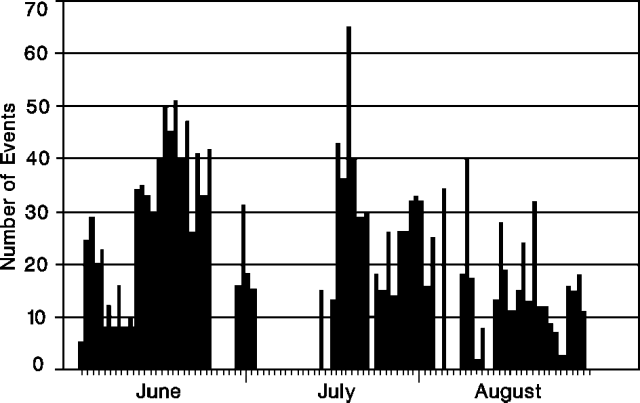Report on Arenal (Costa Rica) — August 1992
Bulletin of the Global Volcanism Network, vol. 17, no. 8 (August 1992)
Managing Editor: Lindsay McClelland.
Arenal (Costa Rica) Lava extrusion and explosive activity; small pyroclastic flows
Please cite this report as:
Global Volcanism Program, 1992. Report on Arenal (Costa Rica) (McClelland, L., ed.). Bulletin of the Global Volcanism Network, 17:8. Smithsonian Institution. https://doi.org/10.5479/si.GVP.BGVN199208-345033
Arenal
Costa Rica
10.463°N, 84.703°W; summit elev. 1670 m
All times are local (unless otherwise noted)
Lava extrusion, explosive activity, and gas emission were continuing in early September. The block-lava flow that has been descending the WSW flank reached 615 m elevation, entering an area of forest and grassland along a front 6-15 m high and 100 m wide. A small area of vegetation was burned. The active lobe was subdivided into two tongues; the southern tongue was advancing at the end of August. By early September, however, its rate of advance was very slow, and a new flow had begun to descend toward the SW, with an active front at 850 m elevation.
Strombolian explosions were infrequent in August; gradual to sudden degassing events were more common. Characteristics of ash collected on the W flank are shown in table 5. Small pyroclastic flows were occasionally generated. Fumarolic activity continued from the old summit crater (D). Acid rain with a mean pH of 4.3 was still affecting vegetation on the W and SW flanks.
Volcanic seismicity generally remained similar to June and July, with an average of 25 events/day and maxima of 30-40 daily (figure 50). Periods of intermittent tremor occurred mainly on 5-7, 11, 14, 17, and 21-22 August.
 |
Figure 50. Number of seismic events recorded (by station FOR) 4 km E of Arenal's active crater, June-August, 1992. Courtesy of ICE. |
Geological Summary. Conical Volcán Arenal is the youngest stratovolcano in Costa Rica and one of its most active. The 1670-m-high andesitic volcano towers above the eastern shores of Lake Arenal, which has been enlarged by a hydroelectric project. Arenal lies along a volcanic chain that has migrated to the NW from the late-Pleistocene Los Perdidos lava domes through the Pleistocene-to-Holocene Chato volcano, which contains a 500-m-wide, lake-filled summit crater. The earliest known eruptions of Arenal took place about 7000 years ago, and it was active concurrently with Cerro Chato until the activity of Chato ended about 3500 years ago. Growth of Arenal has been characterized by periodic major explosive eruptions at several-hundred-year intervals and periods of lava effusion that armor the cone. An eruptive period that began with a major explosive eruption in 1968 ended in December 2010; continuous explosive activity accompanied by slow lava effusion and the occasional emission of pyroclastic flows characterized the eruption from vents at the summit and on the upper western flank.
Information Contacts: G. Soto and R. Barquero, ICE; E. Fernández, J. Barquero, and V. Barboza, OVSICORI.

